Robust Positioning Estimation for Underwater Acoustics Targets with Use of Multi-Particle Swarm Optimization
Abstract
1. Introduction
- (1)
- Due to the impact of various uncertainties such as ocean noise on acoustic signals, they will inevitably affect the accuracy of underwater target positioning. Therefore, it is necessary to process the errors in underwater acoustic measurements in order to provide a basis for subsequent underwater target calculation.
- (2)
- Considering the issue of distributed positioning algorithms being too sensitive to underwater acoustic measurement noise, especially when there are errors in pitch or azimuth measurements, it is necessary to consider various uncertainties in underwater acoustic measurement and establish a distributed solution model.
- (3)
- Simple positioning algorithms cannot achieve optimal output on a global scale, so it is necessary to introduce artificial intelligence optimization algorithms into distributed positioning solution models to reduce the impact of various uncertain measurements on underwater positioning accuracy.
- (4)
- In view of the above research, these stimulate the current work and provide inspiration for the proposed positioning algorithm underwater, which can solve the unstable positioning performance caused by sparse measurement, especially in the case of outliers. The contributions of this article are as follows.
- (5)
- A padding method with weights coupled depending on the geometric distance and azimuth between the underwater target and the transmission transducer is proposed to deal with measurement noises. Additionally, a threshold detection and measurement correction approach based on time series is suggested to reduce the measurement noise.
- (6)
- Considering the sensitivity of measurement noise to the distributed solution, the underwater target localization problem under uncertainties, including distance and azimuth measurements with a single transmission transducer, is transformed into a constrained total least squares problem.
- (7)
- For improving the positioning performance of underwater targets, an improved multi-particle swarm algorithm with an interaction-based search is used to search for more accurate positions near the initial values. In addition, it is equally important to compare the positioning performance with the existing related algorithms based on simulation and platform experiments.
2. Robust Positioning Estimation for Underwater Acoustics Targets
2.1. Underwater Signal-Location Mapping Based on Padding and Correcting
2.2. The Optimal Positioning Problem for Underwater Targets
2.3. Positioning Algorithms Integrated with Intelligent Optimization
| Algorithm 1: Robust positioning estimation for underwater acoustics target |
| Input: ; ; Outputs: ; |
| Deploy a transmission transducer For Do Pad empty ranges; Pad empty angles; If Then Correct by Equation (4); Correct by Equation (5); Calling Subroutine Optimized positioning algorithm; End If End For Subroutine Optimized positioning algorithm Primary estimation by LS; Obtain and under uncertainties; Construct the optimization function by Equation (15); While until the iteration ends Particle swarm initialization by Equation (16); Calculate fitness values; If Then Update position and velocity ; Else Update position and velocity ; End If If is satisfied Then Particle mutation by Equation (21); End If ; End While Output estimation by Equation (22). |
3. Experimental Results and Performance Evaluation
3.1. Numerical Positioning Performance under Simulation Environment
3.2. Experimental Positioning Performance in Underwater Environments
4. Conclusions
Author Contributions
Funding
Institutional Review Board Statement
Informed Consent Statement
Data Availability Statement
Acknowledgments
Conflicts of Interest
References
- Qiao, G.; Muhammad, A.; Muzzammil, M.; Khan, M.S.; Tariq, M.O.; Khan, M.S. Addressing the directionality challenge through RSSI-Based multilateration technique, to localize nodes in underwater WSNs by using magneto-inductive communication. J. Mar. Sci. Eng. 2022, 10, 530. [Google Scholar] [CrossRef]
- Luo, C.M.; Cao, Y.X.; Xin, G.G.; Wang, B.; Lu, E.; Wang, H.L. Three-dimensional coverage optimization of underwater nodes under multiconstraints combined with water flow. IEEE Internet Things J. 2022, 9, 2375–2389. [Google Scholar] [CrossRef]
- Pourkabirian, A.; Kooshki, F.; Anisi, M.H.; Jindal, A. An accurate RSS/AoA-based localization method for internet of underwater things. Ad Hoc Netw. 2023, 145, 103177. [Google Scholar] [CrossRef]
- Liu, L.; Zhang, L.C.; Pan, G.; Zhang, S. Robust yaw control of autonomous underwater vehicle based on fractional-order PID controller. Ocean Eng. 2022, 257, 111493. [Google Scholar] [CrossRef]
- Liu, Y.; Wang, Y.M.; Chen, C.; Liu, C.X. Underwater wireless sensor network-based localization method under mixed Line-of-Sight/Non-Line-of-Sight conditions. J. Mar. Sci. Eng. 2023, 11, 1642. [Google Scholar] [CrossRef]
- Zhang, L.C.; Wang, T.H.; Zhang, F.H.; Xu, D.M. Cooperative localization for multi-AUVs based on GM-PHD filters and information entropy theory. Sensors 2017, 17, 2286. [Google Scholar] [CrossRef] [PubMed]
- Fabijanic, M.; Kapetanovic, N.; Miskovic, N. Autonomous visual fish pen inspections for estimating the state of biofouling buildup using ROV. J. Mar. Sci. Eng. 2023, 529, 1873. [Google Scholar] [CrossRef]
- Song, J.; Li, W.Q.; Zhu, X.W.; Dai, Z.Q.; Ran, C.X. Underwater adaptive height-constraint algorithm based on SINS/LBL tightly coupled. IEEE Trans. Instrum. Meas. 2022, 71, 1–9. [Google Scholar] [CrossRef]
- Almeida, J.; Matias, B.; Ferreira, A.; Almeida, C.; Martins, A.; Silva, E. Underwater Localization System Combining iUSBL with Dynamic SBL in VAMOS! Trials. Sensors 2020, 20, 4710. [Google Scholar] [CrossRef]
- Guo, H.R.; Qian, Z.W.; Wang, X.J.; Sun, W.Z.; Jie, L.; Zhai, J.S. A robust attitude estimation algorithm for seabed inverted ultra-short baseline. Ocean Eng. 2023, 280, 114534. [Google Scholar] [CrossRef]
- Li, Y.H.; Ruan, R.Z.; Zhou, Z.P.; Sun, A.Q.; Luo, X.A. Positioning of unmanned underwater vehicle based on autonomous tracking buoy. Sensors 2023, 23, 4398. [Google Scholar] [CrossRef] [PubMed]
- Yi, J.; Tang, J.; Yuan, F.; Qiao, G.; Dai, D. Non-Uniform clustering algorithm for UWSNs based on energy equalization. Sensors 2023, 23, 5466. [Google Scholar] [CrossRef] [PubMed]
- Luo, C.M.; Wang, B.; Cao, Y.X.; Xin, G.F.; He, C.; Ma, L. A hybrid coverage control for enhancing UWSN localizability using IBSO-VFA. Ad Hoc Netw. 2021, 123, 102694. [Google Scholar] [CrossRef]
- Gehrmann, R.A.S.; Barclay, D.R.; Johnson, H.; Shajahan, N.; Nolet, V.; Davies, K.T.A. Ambient noise levels with depth from an underwater glider survey across shipping lanes in the Gulf of St. Lawrence, Canada. J. Acoust. Soc. Am. 2023, 154, 1735–1745. [Google Scholar] [CrossRef]
- Du, Z.Q.; Chai, H.Z.; Xiang, M.Z.; Zhang, F.; Wang, Z.Y. Resilient model of multi-UUVs cooperative localization for detection of sensor fault and outliers. Ocean Eng. 2022, 266, 113216. [Google Scholar] [CrossRef]
- Fan, S.W.; Zhang, Y.; Hao, Q.; Jiang, P.; Yu, C.Y.; Yu, F. Cooperative positioning for multi-AUVs based on factor graph and maximum correntropy. IEEE Access 2019, 7, 153327–153337. [Google Scholar] [CrossRef]
- Sklivanitis, G.; Markopoulos, P.P.; Pados, D.A.; Diamant, R. Robust graph localization for underwater acoustic networks. In Proceedings of the 2021 Fifth Underwater Communications and Networking Conference (UComms), Lerici, Italy, 31 August–2 September 2021; pp. 1–5. [Google Scholar]
- Liu, X.J.; Liu, X.X.; Zhang, T.W.; Wang, Q.M. Robust data cleaning methodology using online support vector regression for ultra-short baseline positioning system. Rev. Sci. Instrum. 2019, 90, 124901. [Google Scholar] [CrossRef]
- Saeed, N.; Al-Naffouri, T.Y.; Alouini, M.-S. Outlier detection and optimal anchor placement for 3D underwater optical wireless sensor networks localization. IEEE Trans. Commun. 2019, 67, 611–622. [Google Scholar] [CrossRef]
- Sathish, K.; Chinthaginjala, R.; Kim, W.; Rajesh, A.; Corchado, J.M.; Abbas, M. Underwater wireless sensor networks with RSSI-Based advanced efficiency-driven localization and unprecedented accuracy. Sensors 2023, 23, 6973. [Google Scholar] [CrossRef]
- Gong, Z.J.; Li, C.; Jiang, F. AUV-Aided joint localization and time synchronization for underwater acoustic sensor networks. IEEE Signal Process Lett. 2018, 25, 477–481. [Google Scholar] [CrossRef]
- Chen, H.F.; Zhang, L.Y.X.; Liu, F.; Lv, C.L.; Xie, L.; Xiong, S.J.; Wang, H.J.; Yang, S.Q.; Xu, W. Sea experiment of positioning underwater mobile vehicles using multiple surface beacons. In Proceedings of the Global Oceans 2020: Singapore—U.S. Gulf Coast, Biloxi, MS, USA, 5–30 October 2020; pp. 1–6. [Google Scholar]
- Yu, K.G. 3-D localization error analysis in wireless networks. IEEE Trans. Wirel. Commun. 2007, 6, 3472–3481. [Google Scholar]
- Wang, L.; Shen, X.H.; Liu, X.; Hua, F.; Wang, H.Y. Target localization based on weighted total least squares in underwater acoustic networks. In Proceedings of the 2019 IEEE International Conference on Signal Processing, Communications and Computing (ICSPCC), Dalian, China, 20–22 September 2019; pp. 1–5. [Google Scholar]
- Luo, C.M.; Wang, L.X.; Yang, X.D.; Xin, G.F.; Wang, B. Underwater data-driven positioning estimation using local spatiotemporal nonlinear correlation. IEEE/CAA J. Autom. Sin. 2023, 10, 1775–1777. [Google Scholar] [CrossRef]
- Kaliraj, S.; Hariharan, B.; Sivakumar, V.; Josephin, J.S.F.; Siva, R.; Prakash, P.N.S. Doppler shift with archimedes optimization algorithm for localizing unknown nodes in underwater sensor networks. Int. J. Commun. Syst. 2023, 36, e5604. [Google Scholar]
- Singh, P.; Khosla, A.; Kumar, A.; Khosla, M. Optimized localization of target nodes using single mobile anchor node in wireless sensor network. AEU-Int. J. Electron. Commun. 2018, 91, 55–65. [Google Scholar] [CrossRef]
- Wang, S.J.; Wang, S.B.; Liu, W.L.; Tian, Y. A study on the optimization nodes arrangement in UWB localization. Measurement 2020, 163, 108056. [Google Scholar] [CrossRef]
- Hu, K.Y.; Song, X.L.; Sun, Z.W.; Luo, H.J.; Guo, Z.W. Localization based on MAP and PSO for drifting-restricted underwater acoustic sensor networks. Sensors 2018, 19, 71. [Google Scholar] [CrossRef]
- Zhou, Y.F.; Wang, Y.M.; Nie, R.X.; Cheng, Q.; Zhu, G.L. Optimal Location Method of Spontaneous Data Fusion based on TDOA /AOA. In Proceedings of the 2021 OES China Ocean Acoustics (COA), Harbin, China, 14–17 July 2021; pp. 885–889. [Google Scholar]
- Li, J.Q.; Li, L.; Yu, F.J.; Ju, Y.; Ren, J.W. Application of simulated annealing particle swarm optimization in underwater acoustic positioning optimization. In Proceedings of the OCEANS 2019—Marseille, Marseille, France, 17–20 June 2019; pp. 1–4. [Google Scholar]
- Li, W.; Meng, X.; Huang, Y.; Fu, Z.H. Multipopulation cooperative particle swarm optimization with a mixed mutation strategy. Inf. Sci. 2020, 529, 179–196. [Google Scholar] [CrossRef]
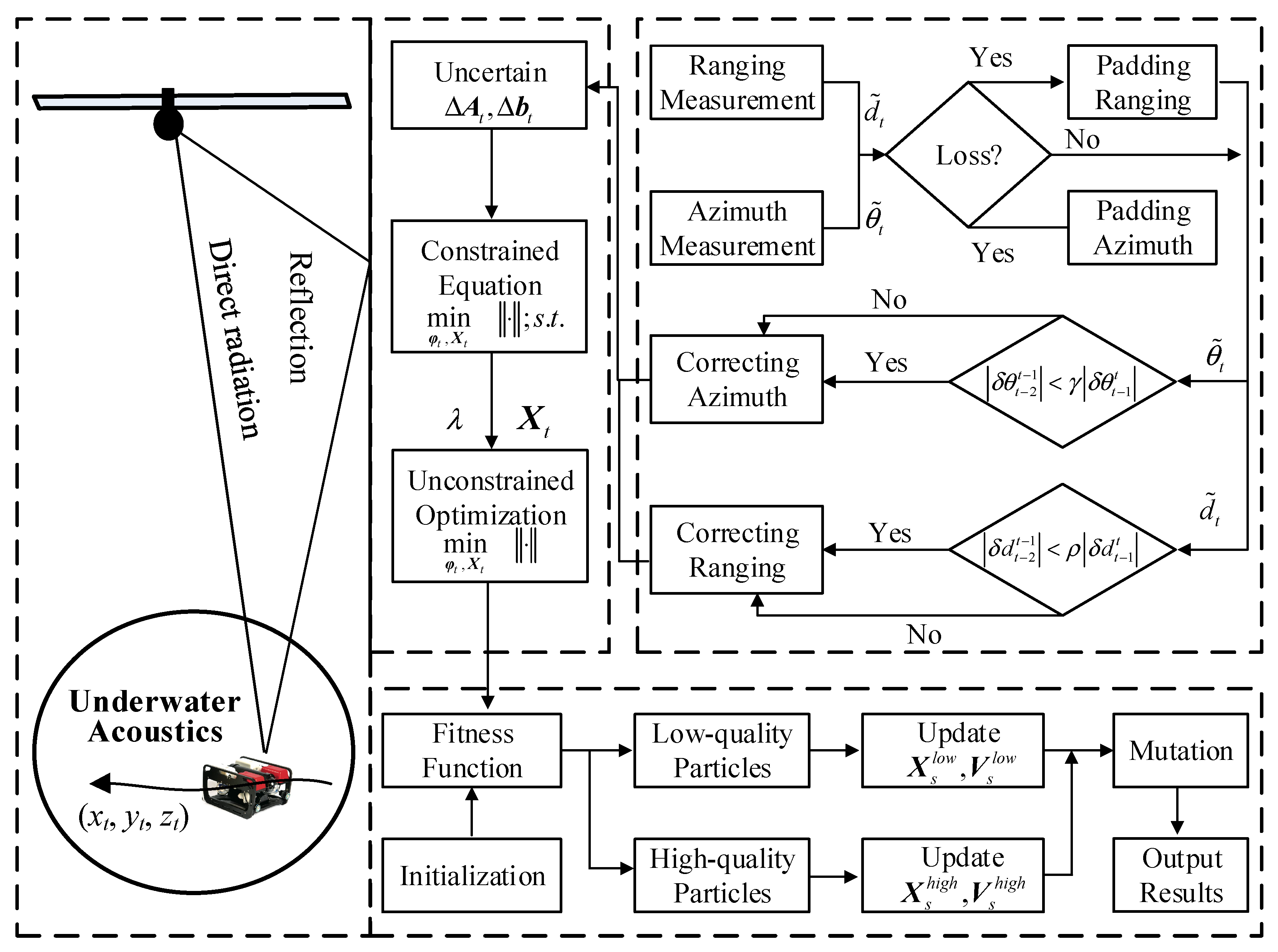
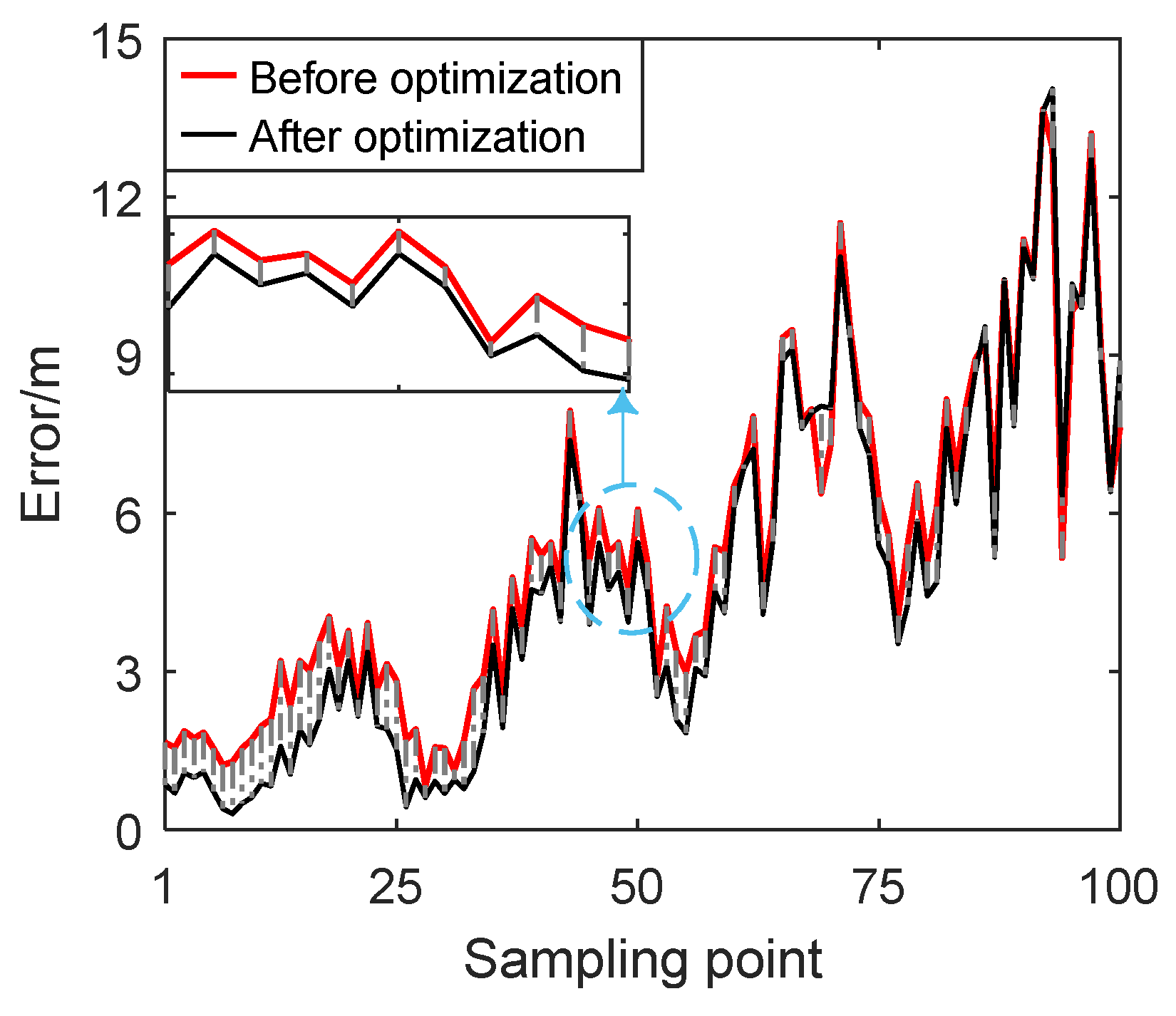
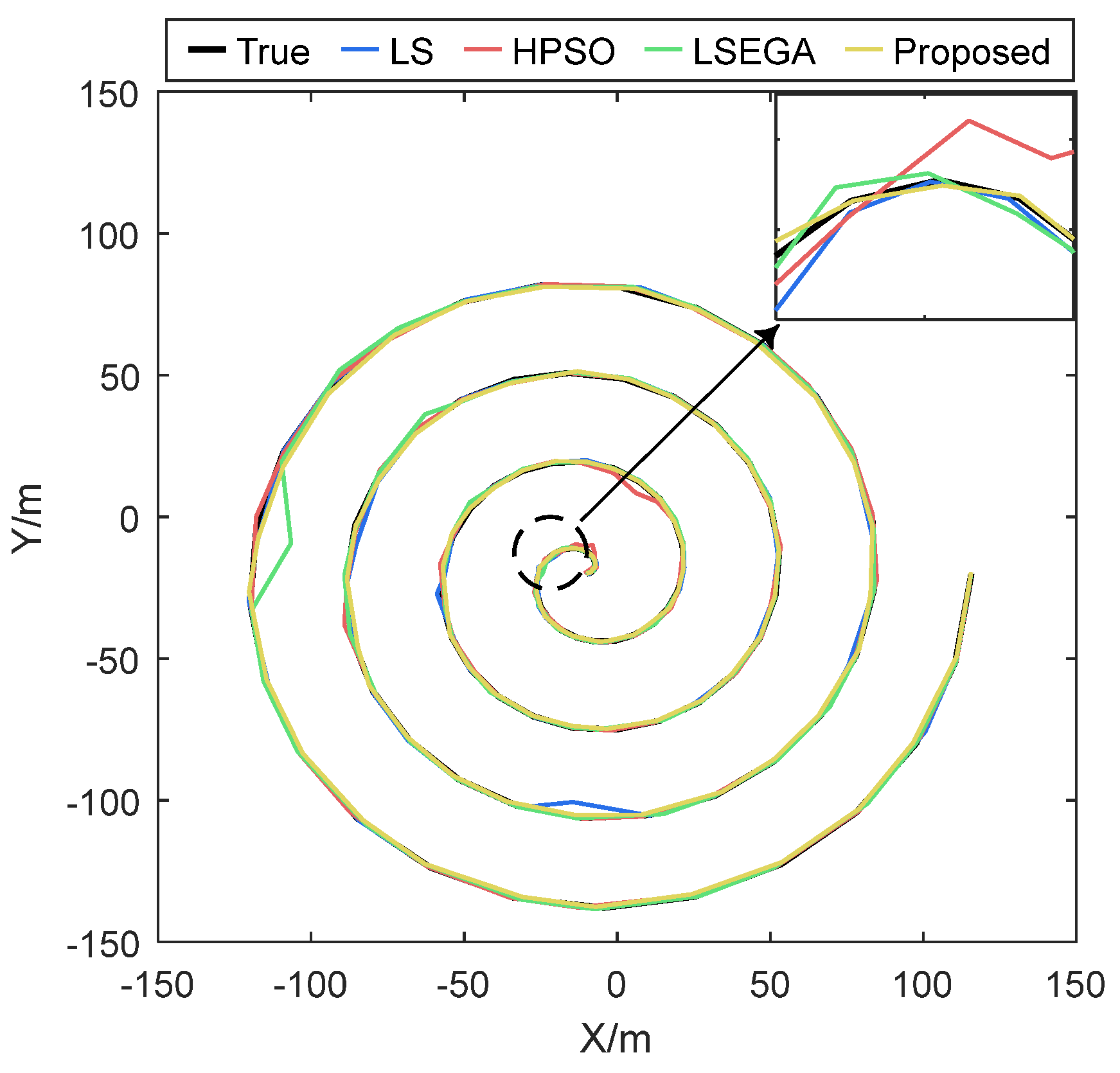

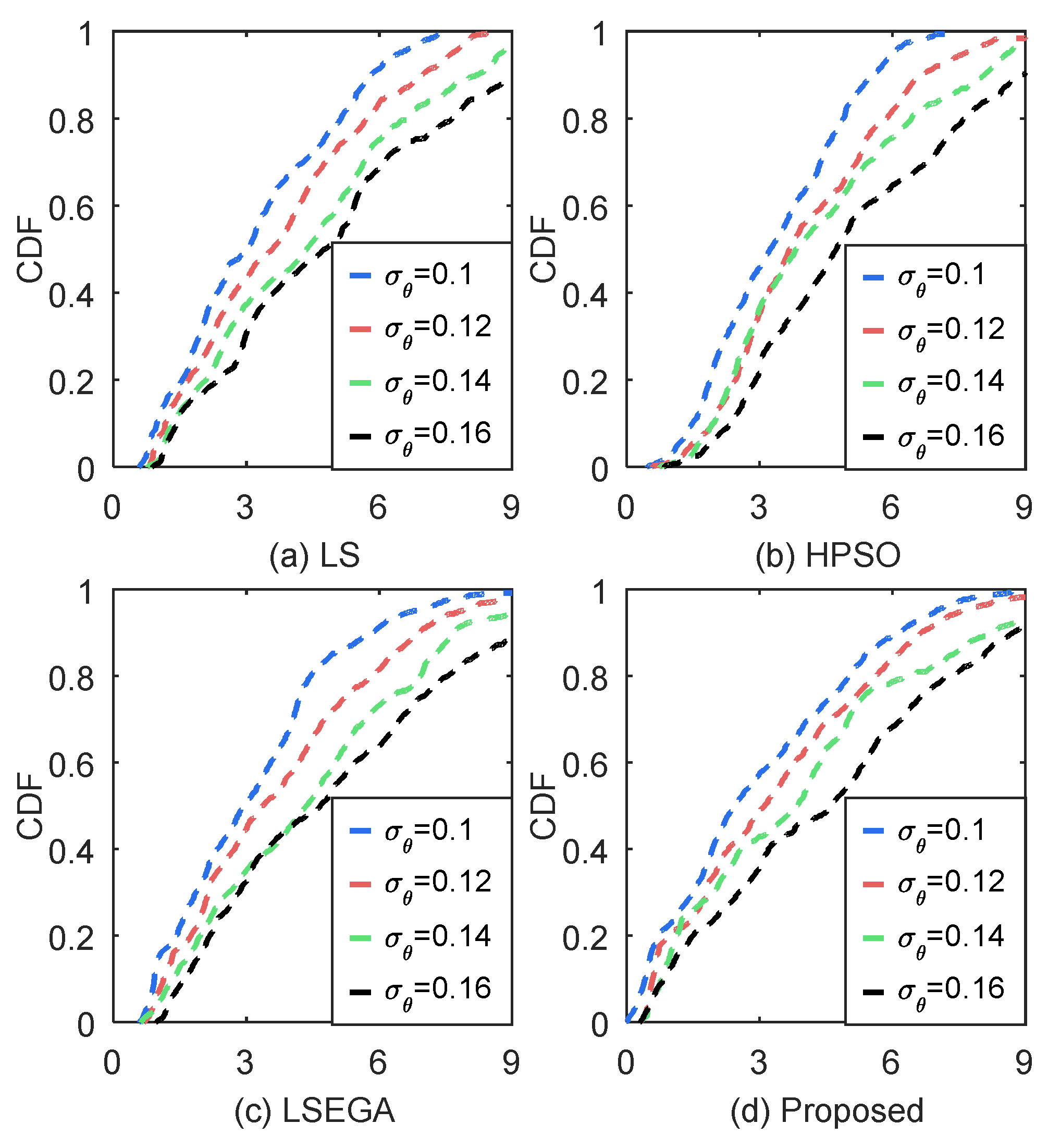
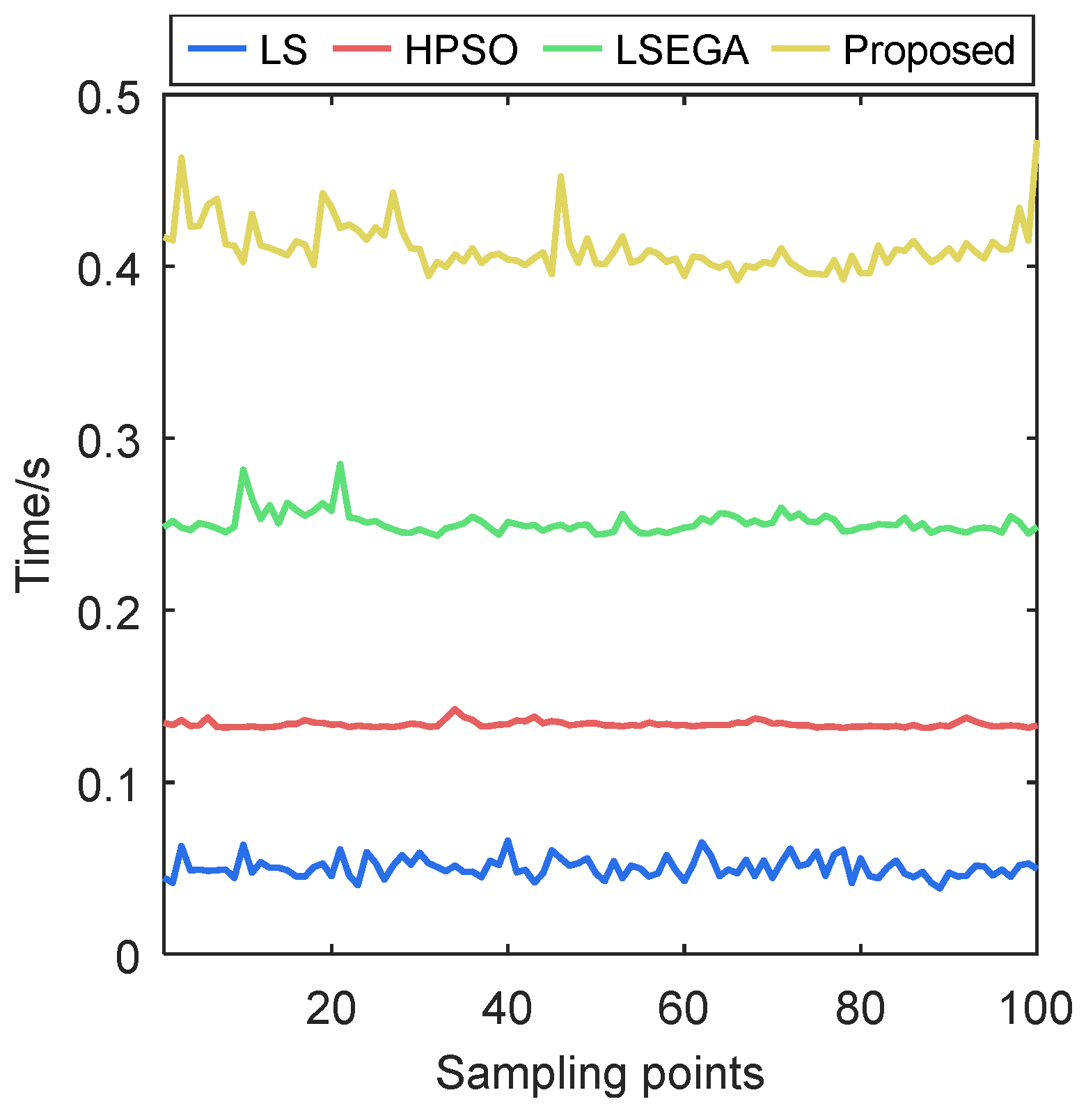
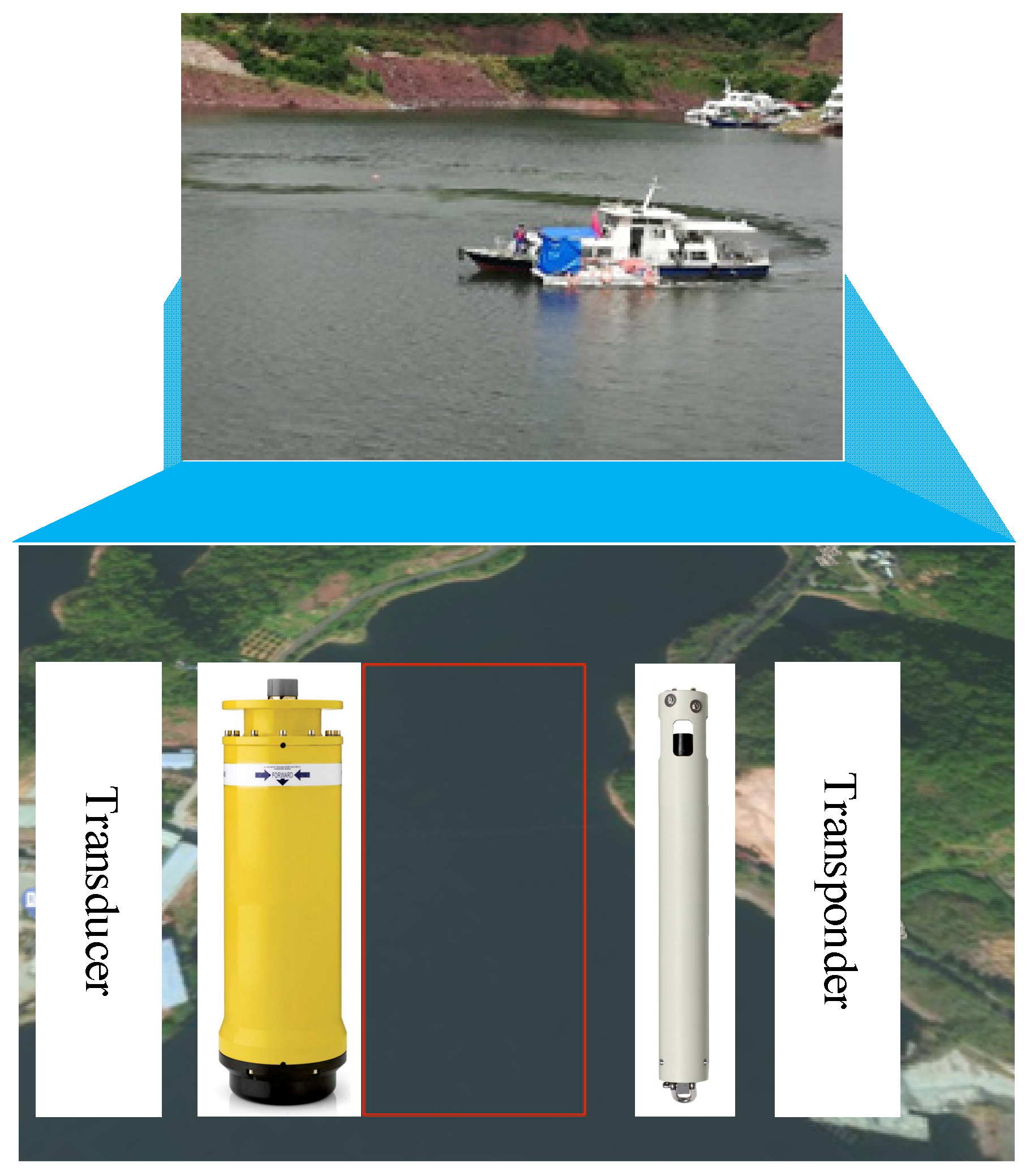
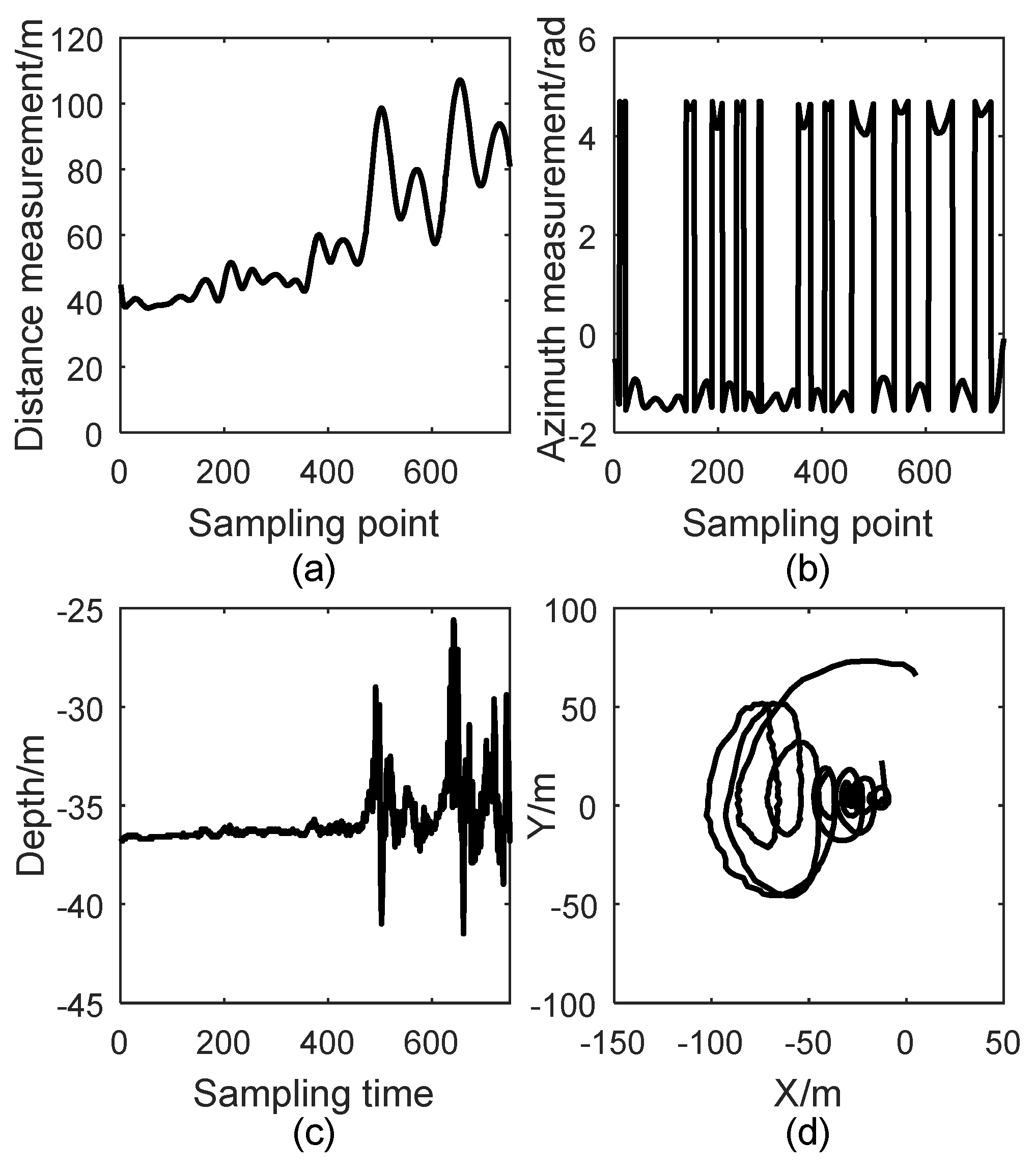
| Parameters | Value |
|---|---|
| 100 s | |
| Distance measurement error | |
| Azimuth error variance | 0.12 to 0.162 |
| 100 | |
| 100 | |
| 5 | |
| −5 | |
| 0.05 | |
| 0.2 | |
| 0.2 |
Disclaimer/Publisher’s Note: The statements, opinions and data contained in all publications are solely those of the individual author(s) and contributor(s) and not of MDPI and/or the editor(s). MDPI and/or the editor(s) disclaim responsibility for any injury to people or property resulting from any ideas, methods, instructions or products referred to in the content. |
© 2024 by the authors. Licensee MDPI, Basel, Switzerland. This article is an open access article distributed under the terms and conditions of the Creative Commons Attribution (CC BY) license (https://creativecommons.org/licenses/by/4.0/).
Share and Cite
Ge, X.; Zhou, H.; Zhao, J.; Li, X.; Liu, X.; Li, J.; Luo, C. Robust Positioning Estimation for Underwater Acoustics Targets with Use of Multi-Particle Swarm Optimization. J. Mar. Sci. Eng. 2024, 12, 185. https://doi.org/10.3390/jmse12010185
Ge X, Zhou H, Zhao J, Li X, Liu X, Li J, Luo C. Robust Positioning Estimation for Underwater Acoustics Targets with Use of Multi-Particle Swarm Optimization. Journal of Marine Science and Engineering. 2024; 12(1):185. https://doi.org/10.3390/jmse12010185
Chicago/Turabian StyleGe, Xiyun, Hongkun Zhou, Junbo Zhao, Xiaowei Li, Xinyu Liu, Jin Li, and Chengming Luo. 2024. "Robust Positioning Estimation for Underwater Acoustics Targets with Use of Multi-Particle Swarm Optimization" Journal of Marine Science and Engineering 12, no. 1: 185. https://doi.org/10.3390/jmse12010185
APA StyleGe, X., Zhou, H., Zhao, J., Li, X., Liu, X., Li, J., & Luo, C. (2024). Robust Positioning Estimation for Underwater Acoustics Targets with Use of Multi-Particle Swarm Optimization. Journal of Marine Science and Engineering, 12(1), 185. https://doi.org/10.3390/jmse12010185





